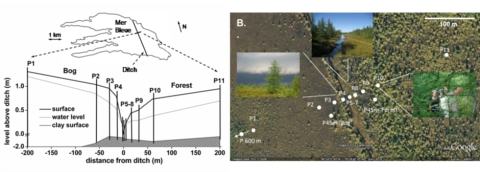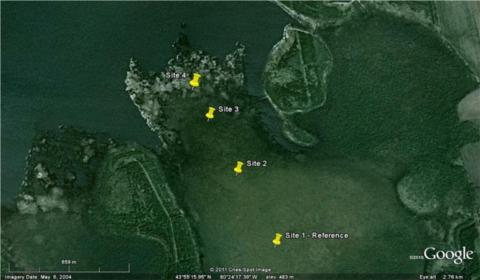DAAD – Carbon and peatlands
Impact of long-term drier and wetter conditions and associated vegetation change on carbon cycling in northern peatlands
Background
Northern peatlands represent an important global carbon stock and source of methane to the atmosphere. The fate of carbon in these environments under changed climatic conditions is thus of considerable scientific interest. Our knowledge of future peatland carbon cycling is deficient with respect to the effects of long-term wetter conditions, both by climate change and by changes in runoff networks surrounding peatlands. Especially important are shifts in system behavior, thresholds and specific inhibition effects that modify the simple relationships between carbon fluxes and environmental controls that have been investigated in the past. These shifts in ecosystem behavior must be analyzed with analogues for the time scale of future environmental changes, i.e. on the multidecadal to centennial scale.
The hypothesis to be tested is that specific thresholds of long-term drying and wetting exist, where distribution of plant function types and as a consequence carbon balance and methane emissions change dramatically. This change does, for example, occur with invasion of trees or grasses in moss- and shrub-dominated bog ecosystems.
The objectives of this project, which are prerequisites for testing the hypothesis, are- to use the carbon ecosystem model PEATBOG to identify the consequences and thresholds of drying and wetting for vegetation dynamics, carbon balance and methane emissions in northern peatlands,
- to obtain the empirical data base in terms of CO2 and CH4 fluxes and the supporting data needed to test the model PEATBOG on long-term drier and wetter sites,
- to identify specific inhibitions that alter the potential for methane emissions from sites undergoing fundamental changes in peat decomposition and vegetation cover.
To reach these objectives, scientists and graduate students have to visit collaborators at Canadian institutions for discussion of the objectives and approaches and to do actual research on-site. These research-oriented visits are funded by this project and are amended by institutional funding that covers other expenses of the research.

Figure 1: Cross section of the study transect (Kopp et al. 2013) installed perpendicular to a drainage ditch in the western part of the Mer Bleue Bog, Ontario, Canada (Panel A), and Google Earth image of the site during the simulation period in September, 2008 (Panel B). Panel (A) illustrates the position of the peat surface, piezometer nest arrangement (P1 - P11), the water level and the peat-clay interface. Peat depth is vertically exaggerated. Panel (B) illustrates the distinct differences in terms of vegetation between both sides of the transect that developed due to drying. The P10 forest site supported on average 4900 g m-2 aboveground biomass, whereas the P1 “reference” site only supported 690 g m-2 (Talbot 2009). 
Figure 2: Already investigated locations in partly flooded Luther Bog, approx. 120 km northwest of Toronto, are depicted. As a result of flooding, a floating mat dominated by Phragmites and Typha developed on the edge of the ombrotrophic bog near the shore line. Peat depth is nowhere smaller than 3 m, even under the floating mat, which suggests that this part of the bog was flooded by the reservoir north and only subsequently transformed. The inlet shows methane emissions from six locations per site in 2012. It is planned to additionally investigate hydrologic and vegetation gradients, for example near site 4, where a transition between dominating shrubs and grasses occurs. Methods
The analysis of long-term change in trace gas emissions by drier or wetter conditions is projected to be carried out with a novel coupled hydrological-biogeochemical simulation tool, the PEATBOG model (Wu and Blodau, 2013). The PEATBOG model V1.1 is implemented in Stella®, and calculates, on a daily time step, the C and N pools in leaves, stems, fine roots and coarse roots in three plant functional types, or PFTs (mosses, graminoids and shrubs), and in labile and recalcitrant soil organic matter pools, and in the dissolved phase in soil water. It consistently emphasizes mass balance principles and the dynamic interplay of production, consumption and translocation of materials throughout the ecosystem.
One consequence of long-term wetter and drier conditions are changes in vegetation cover with grasses and trees that in turn lead to changes in carbon cycling (See Figure 1 for illustration). To better understand such changes it is planned to introduce trees in a new version of the PEATBOG model.
We will further obtain empirical information for the identification of ecohydrological stability and thresholds between dominating types of vegetation and the resulting changes in carbon balances and trace gas fluxes. To these ends CO2 and CH4 chamber flux and soil biogeochemical and hydrological measurements will be carried out in the summer of 2014 and 2015 at the locations shown in Figure 1 and 2. We further plan to study specific inhibitions of methane production that occur at the site Mer Bleue under the newly developed forest cover (Minderlein et al., 2010) with incubation experiments.References
- Wu, Y.; Blodau, C. (2013): PEATBOG: A biogeochemical model for analyzing coupled carbon and nitrogen dynamics in northern peatlands. Geoscientific Model Development 6, 1173-120
- Kopp, B.; Fleckenstein, J.H.; Roulet, T.R.; Humphreys, E.; Talbot, J.; Blodau, C. (2013): Impact of long-term drainage on groundwater flow patterns in the Mer Bleue peatland, Ontario, Canada. Hydrology and Earth System Science 17,3485–3498, 2013.
- Minderlein, S., Blodau, C. (2010): Humic-rich peat extracts inhibit sulfate reduction, methanogenesis, and anaerobic respiration but not acetogenesis in peat soils of a temperate bog, Soil Biology and Biochemistry, 42(12), 2078-2086
Students
For 2015 we are seeking M.Sc. candidates for thesis work within this project. Possible thesis topics include:
- The application and further development of the PEATBOG model for simulating the effects of drier and wetter conditions of peatlands. This work will encompass a visit of project collaborator Dr. Yuanqiao Wu in Toronto.
- The quantification of trace gas emissions and soil respiration with chamber approaches soil incubations and gas chromatography. For this work a visit at the laboratory of project collaborator Prof. Tim Moore at McGill University, Montreal, will be needed.
- The identification of factors that cause an inhibition of methanogenesis at the site Mer Bleue. To this end incubations experiments with peats and soil solutions have to carried out.
Further information also with respect to research assistantships is provided by Prof. Dr. Christian Blodau.
Info
Project Partners and contact
University of Muenster
Institute of Landscape Ecology, Hydrology Group
Principal Investigator: Prof. Christian Blodau, Dr. Yuanqiao Wu (now at Environment Canada)
McGill University, Montreal, Kanada
Department of Geography
Prof. Dr. Tim Moore
Funding
German Academic Exchange Service (DAAD)
Project period: 01/2014 – 12/2015


